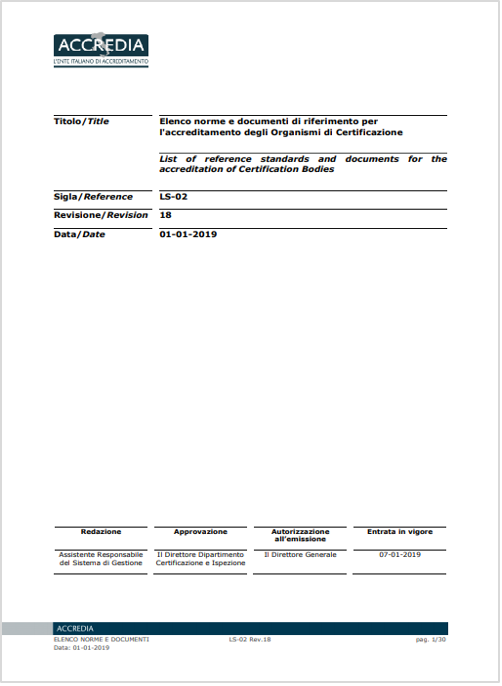Informazione tecnica HSE / 25 ° anno
/ Documenti disponibili:
45.629
/ Documenti scaricati: 34.651.417
/ Documenti scaricati: 34.651.417
ID 23020 | 27.11.2024 / Full attached - International Workshop Agreement (IWA) 48:2024
Foreword
ISO (the International Organization for Standardization) is a worldwide federation of national standards bodies (ISO member bodies).
The work of preparing International Standards is normally carried out through ISO technical committees. Each member body interested in a subject for which a technical committee has been established has the right to be represented on that committee. International organizations, governmental and non-governmental, in liaison with ISO, also take part in the work. ISO collaborates closely with the International Electrotechnical Commission (IEC) on all matters of electrotechnical standardization.
The procedures used to develop this document and those intended for its further maintenance are described in the ISO/IEC Directives, Part 1. In particular, the different approval criteria needed for the different types of ISO documents should be noted. This document was drafted in accordance with the editorial rules of the ISO/IEC Directives, Part 2 (see www.iso.org/directives).
ISO draws attention to the possibility that the implementation of this document may involve the use of (a) patent(s). ISO takes no position concerning the evidence, validity or applicability of any claimed patent rights in respect thereof.
As of the date of publication of this document, ISO had not received notice of (a) patent(s) which may be required to implement this document. However, implementers are cautioned that this may not represent the latest information, which may be obtained from the patent database available at www.iso.org/patents. ISO shall not be held responsible for identifying any or all such patent rights.
Any trade name used in this document is information given for the convenience of users and does not constitute an endorsement.
For an explanation of the voluntary nature of standards, the meaning of ISO specific terms and expressions related to conformity assessment, as well as information about ISO’s adherence to the World Trade Organization (WTO) principles in the Technical Barriers to Trade (TBT), see www.iso.org/iso/foreword.html.
International Workshop Agreement IWA 48 was approved at virtual workshops hosted jointly by the Brazilian Technical Standards Association (ABNT), the British Standards Institution (BSI) and the Standards Council of Canada (SCC), in July and October 2024.
Any feedback or questions on this document should be directed to the user’s national standards body. A complete listing of these bodies can be found at www.iso.org/members.html.
Introduction
0.1 What is ESG?
Environmental, Social and Governance (ESG) is a strategic and operational framework that aims to assist organizations, of any size and type, to implement and report on their activities, products, services and commitment to support the achievement of sustainable development, social justice and good governance. Adopting ESG brings a clearer focus on an organization’s impacts on the environment and society, including contribution to the delivery of the United Nations (UN) Sustainable Development Goals (SDGs), as well as evaluating the impacts of the environment and society on the organization.
ESG is distinctive for organizations partly because it focuses the attention of decision-makers on the impacts and accountability of organizations with respect to communities, the environment and everyday lives. Regulatory bodies, policy makers and investors are particularly interested in ESG for this precise reason, and because everyone has the potential to be an interested party in the outcomes of ESG activities.
Being open, honest and factual about all aspects of the organization is a positive ESG trait which underpins good governance (the “G” of ESG) that takes full account of the direct and indirect, individual and collective end-outcomes of organizations’ activities, products and services and has regard for external influences, regardless of their source, type, size or jurisdiction, including their supply chains and customers.
ESG involves accurate and regular reporting of financial and non-financial material impacts, but ESG is not just about reporting. The focus of this document is deliberately on the implementing and embedding of ESG practices and values throughout an organization’s culture and activities.
EXAMPLE 1
ESG can include:
- Environmental (E): climate change mitigation and adaptation, sustainable resource use and energy efficiencies, circular economy, prevention of pollution and waste management, protection of the environment, biodiversity and restoration of natural habitats.
- Social (S): internal and external social factors and impacts, including human rights, labour practice, decent work, consumer issues, community relations and engagement (including involvement in, influencing and embedding the organization’s ESG activities), privacy and data protection, health, well-being and safety, supply chain management, other human capital and social justice issues.
- Governance (G) of the organization, including the governing of the environmental (E) and social (S) categories: corporate board composition and structure, strategic sustainability oversight and compliance, executive compensation, anti-corruption, responsible political involvement, fair competition, promoting social responsibility in the value chain, respect for property rights and interrelationship with communities and society.
ESG draws on and supports the UN SDGs to help define positive social and environmental outcomes. Furthermore, ESG can be considered as connected to and convergent with sustainable development.
EXAMPLE 2
SDG 6 is to ensure the availability and sustainable management of water and sanitation for all. Access to safe water, sanitation and hygiene can be a material consideration for the organization and the communities it is engaged with. ISO 4600 can help organizations or communities who heavily rely on water activities with demonstrating their ESG credentials.
This document is intended as a contribution for organizations considering the impacts of the 17 SDGs and how they can optimize the links between ESG activities in the context of selected SDGs.
NOTE ISO in collaboration with UNDP have developed guidelines for contributing to the UN SDGs (ISO/UNDP PAS 53002)[3].
0.2 ESG landscape
ESG’s broad perspective necessitates a wider set of reporting standards, both financial and increasingly non-financial, that allow organizations to demonstrate their current state of ESG achievement, progress or maturity and to ensure certain levels of regulatory compliance or conformity with national or internationally agreed ESG standards. Many interested parties need to be able to rely on and understand the ESG reports. Therefore, more than ever, the measurement and reporting of environmental and social outcomes need to be undertaken and performed in a standardized, credible and verifiable way.
The ESG landscape is currently complex. There are many overlapping and competing ESG standards and frameworks, some mandatory requirements, some voluntary and some commercial. Different methodologies and forms of measurement, varied definitions and competing approaches result in confusion and this has undermined the trust in ESG claims which, in turn, has tended to discourage investment and further engagement in ESG by organizations.
0.3 The evolving ESG landscape
As regulation and legislation on ESG develops around the world, there is an increasing awareness that mandatory disclosure and market transparency around ESG outcomes, impacts, risks and opportunities will continue to expand. The continued expansion of ESG and sustainability reporting and disclosure requirements over the next few years are likely to focus organizations’ attention on how to manage the increasing demands. For example, senior finance and sustainability executives in large corporations are increasingly recognizing the need to be well prepared in ESG reporting as new requirements unfold.
The overall ESG landscape is evolving and extending:
- Senior executives understand that meeting ESG requirements requires engagement with a broad range of interested parties. While ESG demands typically come from investors, board members, shareholders and customers, it is critical to consider the interests of all interested parties including personnel, customers, supply and value chain partners, regulatory bodies and the communities in which they are located and serve. Increasingly, shareholders (including the more vocal activist shareholders) are demanding more emphasis on sustainability and ESG impacts.
- The number of organizations that ESG covers is expanding, including smaller interested parties (e.g. small and medium enterprises [SMEs]) who are seeking or developing ESG goals similar to those of large corporations, on a voluntary basis. They require as much support, guidance and attention as those who are mandated to report and disclose.
- The tendency has been to focus mainly on climate-related risks, resource use and circularity, such as achieving net zero and other environmental reporting requirements. Environmental focus has dominated ESG in corporate settings. Increasingly social and governance factors need to strengthen given the recognition that the environmental and social factors have to coexist and be incorporated into the governance of an organization.
- There is recognition of how ESG information and frameworks are implemented and practised. Organizations of all types and sizes are determining how to build ESG information.
- The important directions for organizations include:
- how to maximize the potential of ESG data and information for building organizational ESG profiles, managing impacts, improving sustainability and providing evidence for functional accountability;
- monitor and evaluate the quality of their ESG performance;
- improve their decision-making;
- identify trends and employ analytics to monitor their policies and direction for ESG improvements.
Implementing the ESG framework can improve and accelerate organizational strategies and actions on sustainability by shaping policies and practices related to the environment, social values and conditions. The increased value resulting from adopting the ESG framework is demonstrated through ESG strategies, actions and how ESG reporting is conducted. Therefore, ESG strengthens both the organization and the community.
There is a growing recognition that ESG can and should be viewed as a core lever in an organization’s success, by expanding its economic, environmental and social development pathways, building competitive advantage and accelerating sustainability and prosperity.
0.4 ESG framework
This document, as an ESG framework, provides overarching principles, a coherent structure and guidance for ESG, so that all interested parties can be reassured that they are working within the same set of principles. This ESG framework is intended to be flexible so it can be applicable to organizations of all sizes, sectors and jurisdictions, while reflecting changes in emphasis that can emerge within ESG more widely. This document allows for regional and economic differences, including flexibility for organizations in developing regions and those with limited resources. For example, the framework is designed to be accessible to SMEs and organizations in developed and developing countries, whether they are required to report on ESG or are engaging in ESG on a voluntary basis.
The document offers incremental pathways for organizations with limited regulatory oversight or technical capacity, enabling all organizations to engage in ESG practices.
An ESG strategy and implementation are intended to propel sustainability. Pursuing this document’s ESG principles can add significant value to an organization in terms of:
- raising capital: ESG can be a requirement/rating criterion;
- regulatory relationships: “green” labelling and marketing are already or in the process of being regulated and climate-related disclosure requirements for many organizations are likely to increase;
- customers: increasingly customers can buy or be retained on the basis of ESG “values”;
- personnel: drawn to organizations with a pro-ESG culture;
- shareholders: potential improved returns, future proofing, reducing reputational risk;
- resource utilization: improving the circularity of finite resources;
- climate mitigation and adaptation actions: promoting climate transition and enhancing resilience.
The aim of this document is to assist as wide a group of interested parties as possible and to help organizations of all types and sizes to start, deepen or mature their ESG journey in a clear, accessible and straightforward manner. The ESG framework is intended to be complementary to and interoperable with existing voluntary and regulatory reporting frameworks to facilitate global harmonization and alignment on ESG principles and approaches. The ESG framework (see Figure 1) draws on relevant existing International Standards, without rewriting them, to bring together trusted materials in an overarching structure of principles and cross-cutting themes supported by key performance indicators (KPIs).
This document responds directly to the identified needs of interested parties, including businesses, investors, communities, governments and consumers, who in turn need to respond to regulatory requirements. This document is outcome-focused and performance-based, enabling a holistic and measurable approach, facilitating sustainable change.
The principles framework in this document focuses on the non-financial aspects of claims, reporting and disclosure and not solely on accounting practices. Tangibles and intangibles should be integrated within the evaluation of risks and opportunities.
The main components of this document are presented in Figure 1.
Figure 1 Main components of the ESG framework
...
add attached
Collegati

ID 17717 | 30.09.2022 / In allegato Preview
UNI EN ISO 19014-2:2022 Macchine movimento terra - Sicurezza funzionale - Parte 2: Progettazione e valutazione dei requisiti hardware ...

Elenco norme e documenti di riferimento per l'accreditamento degli Organismi di Certificazione / List of reference standards and documents for th...

ISO/IEC 17025 enables laboratories to demonstrate that they operate competently and generate valid results, thereby promoting confidenc...
Testata editoriale iscritta al n. 22/2024 del registro periodici della cancelleria del Tribunale di Perugia in data 19.11.2024